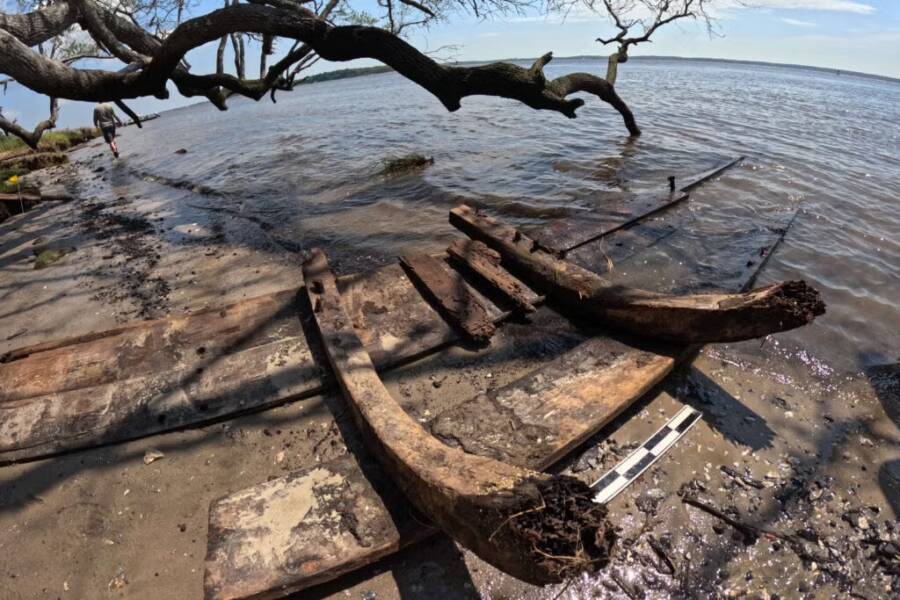La Fortuna sank off the coast of colonial Brunswick Town, North Carolina, during an attack in September 1748.

ECU Program in Maritime StudiesGraduate student Cory van Hees noticed wooden planks on the floor of the Cape Fear River while mapping a colonial wharf.
Field researchers and students from East Carolina University recently found the wreckage of a ship off the North Carolina coast that appears to be linked to the Spanish privateer La Fortuna. La Fortuna exploded in 1748 after an attack on Brunswick Town turned out unfavorably for the ship’s crew.
So far, over 40 pieces of lumber have been recovered from the wreck. However, experts are warning that any additional excavations need to happen soon, as erosion and other hazards threaten the future conservation of the ship’s remains.
A Historic Discovery Made By Complete Accident
In a statement released by East Carolina University, archaeologists explained how the species of wood recovered from the shipwreck could indicate the vessel’s origins.
The wood samples collected from the site reveal that some of the wood used in the construction of the vessel was sourced either from Monterey cypress or Mexican cypress, trees that are native to southern California and Central America. This suggests the ship’s builders used raw materials from Spanish Caribbean colonies in the 18th century — and the only reported shipwreck of Spanish origin in the area was La Fortuna.
More work needs to be done to confirm this early theory, but there seems to be at least some evidence to support it. This is even more remarkable considering that the discovery was entirely serendipitous.
“My dive buddy, Evan Olinger, and I were taking width measurements of Wharf Four to help delineate the site,” said maritime studies graduate student Cory van Hees. “The visibility is consistently pretty low in the Cape Fear River. Evan attempted to find the Northern extent of the wharf but had become disoriented due to the conditions. We switched roles, and the same happened to me on my attempt.”
While lost in his search, however, van Hees stumbled upon some wooden frames jutting out of the clay mud. On the surface, he noticed barely visible signs of planking.
“I didn’t understand what I was looking at in that moment,” he said, “but I knew I should relay the wooden structure to faculty. Later that day, Dr. Jason Raupp was able to confirm this was a wreck, which may be La Fortuna. It was kind of overwhelming and a little emotional feeling once it set in.”
The Tragic Fate Of ‘La Fortuna’
Although relatively obscure in terms of maritime history, La Fortuna and its crew earned their own little slice of significance thanks to their particularly destructive footnote during King George’s War.
In September 1748, La Fortuna and a companion ship attacked the British colonial settlement at Brunswick Town, North Carolina. The privateers looted the place, and then — unfortunately for them, but luckily for the townsfolk — La Fortuna suddenly exploded, obliterating most of its crew but ensuring its place in history.
And while modern reporting often refers to the crew of La Fortuna as “pirates,” they were more technically “privateers.” Pirates operated outside the law; privateers, on the other hand, were authorized by governments to attack enemy ships during wartime. Privateering was, in a sense, legally sanctioned chaos.
Further Discoveries And Conservation Concerns
During the summer field school season, three other shipwreck sites were uncovered at the Brunswick Town/Fort Anderson State Historic Site (BTFA) waterfront.
Early analysis suggests one ship had been used for land reclamation at the waterfront, while another may have been a colonial flatboat — a watercraft that once transported people and goods between plantations and the port, similar to a ferry. The fourth wreck, meanwhile, was “barely exposed” and remains unidentified.
These discoveries may have been exciting for ECU archaeologists, but they also highlighted how at-risk the wrecks are. Ongoing erosion at BTFA from channel dredging, storms, and “dynamic wave energy” is continuing to cause substantial damage to the site’s shoreline. Erosion and strong waves threaten to drag the shipwrecks further under and scatter their remains.
The 40 timbers recovered showed a “remarkable degree of preservation,” including tool markings left by the shipwright. They have since been transferred to the North Carolina Office of State Archaeology’s Queen Anne’s Revenge Conservation Laboratory at ECU’s West Research Campus in Greenville for storage and conservation treatment.
“We are extremely excited about these important sites, as each one will help us to better understand the role of BTFA as one of the state’s earliest colonial port towns,” said Dr. Jason Raupp, the ECU professor who directed the field project.
Raupp continued, “These submerged colonial waterfront features are incredibly well-preserved and present an excellent opportunity for ECU students to engage in hands-on, collaborative research.”
After reading about the potential discovery of the wreck of La Fortuna, read about the history of the Carroll A. Deering, the “Ghost Ship” of North Carolina. Then, learn all about the eerie mystery of another ghost ship: the Mary Celeste.





